Everyday Use of the City Cemetery: A Study of Environmental Qualities and Perceived Restorativeness in a Scottish Context
Abstract
1. Introduction
1.1. The Everyday Use of Historical Urban Cemeteries
1.2. Environmental Qualities and Perceived Restorativeness in the Cemetery
2. Methods
2.1. Study Design and Participants
2.2. Study Sites
2.3. Behavioural Observations
Data Collection
2.4. Interviewer-Administered On-Site Survey
2.4.1. Measures
2.4.2. Data Analysis
2.5. Face-to-Face On-Site Interviews
2.5.1. Interviews
2.5.2. Data Analysis
3. Results
3.1. Behavioural Observations
3.2. Interviewer-Administered On-Site Survey
3.3. Face-to-Face On-Site Interviews
3.3.1. Safety
‘I do know there are drug addicts who lay syringes in the playground, so I imagine they do it here as well, I don’t know though. I think it’s not safe to walk in any parkland after dark or dark area in the city anywhere in Britain, and I imagine the same in other countries for women in particular.’(Pauline, female, aged 57, Morningside Cemetery)
‘I sometimes walk through here to go home at night. It’s a very good neighbourhood, and I don’t have any negative associations with this cemetery. I kind of grew up next to a very big park like a cemetery, so it’s normal for me. I think this place is very peaceful.’(Monica, female, aged 25, Warriston Cemetery)
3.3.2. Usage
‘I am on the way home from the shops. This is a short-cut.’(Sandy, female, aged 67, Morningside Cemetery)
‘In Edinburgh, it’s very difficult to find an enclosed area. The parks are all open. Because of the enclosed environment here, I can let my dogs off the leash and they can run around freely.’(Candy, female, aged 52, Warriston Cemetery)
3.3.3. Facilities
‘It’s my backyard garden! I usually sit on the bench drinking beer with my friends on weekends. I think it is a very nice place, very quiet and peaceful.’(Betty, female, aged 30, Morningside Cemetery) (Figure 7)
‘I don’t think if it’s necessary to have any facilities in the cemetery. It’s a cemetery, not a park.’(Nina, female, aged 83, Warriston Cemetery)
3.3.4. Aesthetics
‘When I am walking home, I prefer it, compared to the regular street or other parks. Because it’s a little bit more scenic and calm. So I come here five to six times a week. I like the flowers and I like looking at different designs of gravestones, which make this place unique’(Monica, female, aged 25, Morningside Cemetery)
‘I like the curved pathways of this place. It’s well designed. As I am recovering from illness, it’s good to have some stairs and steep roads where I can do exercise.’(Kingston, male, aged 42, Warriston Cemetery)
‘I notice there is a grave in the middle which always has lots of flowers. It has been like that for many years…it’s a very young child, so I thought that was very sad…I don’t know if I would do the same if it was my child. This is many, many years later and she is still doing it, so that’s extraordinary that she is still honouring that memory of her child.’(Pauline, female, aged 57, Morningside Cemetery)
4. Discussion
4.1. The Everyday Use of Historical Urban Cemeteries
4.2. Environmental Qualities and Perceived Restorativeness in the Cemeteries
5. Limitations
6. Conclusions
Author Contributions
Funding
Acknowledgments
Conflicts of Interest
Declarations
Appendix A
| Component | ||||
|---|---|---|---|---|
| 1 | 2 | 3 | 4 | |
| Safety | Usage | Facilities | Aesthetics | |
| The paths to the cemetery are safe to walk after dark | 0.796 | |||
| The cemetery is safe to walk after dark | 0.707 | |||
| The cemetery is free from crime | 0.681 | |||
| The paths to the cemetery are easy to walk on | 0.562 | |||
| The cemetery is good for children to play in | 0.763 | |||
| The paths to the cemetery are enjoyable to walk through | 0.710 | |||
| Many different activities take place in the cemetery | 0.606 | |||
| The cemetery is good for chatting with people | 0.517 | |||
| There are good facilities in the cemetery | 0.903 | |||
| Trees and plants in the cemetery are attractive | 0.840 | |||
| Cronbach’s Alpha Score | 0.662 | 0.584 | ||
| % of Variance explained | 21.15 | 19.32 | 12.28 | 11.03 |
References
- Bowler, D.E.; Buyung-Ali, L.M.; Knight, T.M.; Pullin, A.S. A systematic review of evidence for the added benefits to health of exposure to natural environments. BMC Public Health 2010, 10, 456. [Google Scholar] [CrossRef]
- Hipp, J.A.; Gulwadi, G.B.; Alves, S.; Sequeira, S. The Relationship Between Perceived Greenness and Perceived Restorativeness of University Campuses and Student-Reported Quality of Life. Environ. Behav. 2016, 48, 1292–1308. [Google Scholar] [CrossRef]
- Kaplan, R.; Kaplan, S. The Experience of Nature: A Psychological Perspective; Cambridge University Press: Cambridge, UK; New York, NY, USA, 1989; Available online: https://books.google.com.hk/books?hl=en&lr=&id=7l80AAAAIAAJ&oi=fnd&pg=PR7&ots=TpL3RFpa3k&sig=AMu2guU28KGiIT70_Pu2GRtmAck&redir_esc=y#v=onepage&q&f=false (accessed on 10 January 2019).
- Hartig, T.; Korpela, K.; Evans, G.W.; Gärling, T. A measure of restorative quality in environments. Scand. Hous. Plan. Res. 1997, 14, 175–194. [Google Scholar] [CrossRef]
- Bastian, O.; Haase, D.; Grunewald, K. Ecosystem properties, potentials and services—The EPPS conceptual framework and an urban application example. Ecol. Indic. 2012, 21, 7–16. [Google Scholar] [CrossRef]
- Næss, P. Residential location affects travel behavior—But how and why? The case of Copenhagen metropolitan area. Prog. Plan. 2005, 63, 167–257. [Google Scholar] [CrossRef]
- Rupprecht, C.D.D.; Byrne, J.A.; Ueda, H.; Lo, A.Y. ‘It’s real, not fake like a park’: Residents’ perception and use of informal urban green-space in Brisbane, Australia and Sapporo, Japan. Landsc. Urban Plan. 2015, 143, 205–218. [Google Scholar] [CrossRef]
- Anderson, E.C.; Minor, E.S. Vacant lots: An underexplored resource for ecological and social benefits in cities. Urban For. Urban Green. 2017, 21, 146–152. [Google Scholar] [CrossRef]
- Jackson, J.D.; Smith, J.; Shah, J.P.; Wisniewski, S.J.; Dahm, D.L. Golf after total knee arthroplasty: Do patients return to walking the course? Am. J. Sports Med. 2009, 37, 2201–2204. [Google Scholar] [CrossRef]
- Pals, R.; Steg, L.; Siero, F.W.; van Der Zee, K.I. Development of the PRCQ: A measure of perceived restorative characteristics of zoo attractions. J. Environ. Psychol. 2009, 29, 441–449. [Google Scholar] [CrossRef]
- Nordh, H.; Evensen, K.H.; Skår, M. A peaceful place in the city—A qualitative study of restorative components of the cemetery. Landsc. Urban Plan. 2017, 167, 108–117. [Google Scholar] [CrossRef]
- Brown, T. The making of urban ‘healtheries’: The transformation of cemeteries and burial grounds in late-Victorian East London. J. Hist. Geogr. 2013, 42, 12–23. [Google Scholar] [CrossRef]
- Evensen, K.H.; Nordh, H.; Skaar, M. Everyday use of urban cemeteries: A Norwegian case study. Landsc. Urban Plan. 2017, 159, 76–84. [Google Scholar] [CrossRef]
- Harrison, A.R. National Land Use Database: Land Use and Land Cover Classification; version 4.4; Office of the Deputy Prime Minister: London, UK, 2006. Available online: https://assets.publishing.service.gov.uk/government/uploads/system/uploads/attachment_data/file/11493/144275.pdf (accessed on 8 November 2018).
- Francis, D. Cemeteries as cultural landscapes. Mortality 2003, 8, 222–227. [Google Scholar] [CrossRef]
- Morelli, F.; Mikula, P.; Benedetti, Y.; Bussière, R.; Jerzak, L.; Tryjanowski, P. Escape behaviour of birds in urban parks and cemeteries across Europe: Evidence of behavioural adaptation to human activity. Sci. Total Environ. 2018, 631–632, 803–810. [Google Scholar] [CrossRef]
- Indrawati, S.; Soetomo, B.; Setioko, T.W.; Murtini, T.W.; Nurhasan, T.W. Edu—Religious Tourism Based on Islamic Architecture Approach, a Prelimenary Research in Majasto Cemetery—Sukoharjo Regency Central Java. Procedia Soc. Behav. Sci. 2016, 227, 656–663. [Google Scholar] [CrossRef]
- Swensen, G.; Nordh, H.; Brendalsmo, J. A green space between life and death—A case study of activities in Gamlebyen Cemetery in Oslo, Norway. Nor. Geogr. Tidsskr. Nor. J. Geogr. 2016, 70, 41–53. [Google Scholar] [CrossRef]
- Tângari, V.R. Open Space Systems in Rio de Janeiro: The Public and Private Spheres Reflected in the Urban Landscape. In Urban Public Spaces from Planned Policies to Everyday Politics (Illustrated with Brazilian Case Studies); Capanema Alvares, L., Barbosa, J.L., Eds.; Springer International Publishing: Cham, Switzerland, 2018; pp. 109–126. Available online: https://link.springer.com/book/10.1007%2F978-3-319-74253-3 (accessed on 9 October 2018).
- Firth, R. Foreword: The Body in the Sacred Garden. In The Secret Cemetery, English ed.; Doris, F., Kellaher, L., Neophytou, G., Eds.; Berg Publishers: Oxford, UK; New York, NY, USA, 2005; Available online: https://scholar.google.com/scholar?hl=en&as_sdt=0,5&cluster=15010529624822592883 (accessed on 12 May 2018).
- Francis, D.; Kellaher, L.; Neophytou, G. Sustaining cemeteries: The user perspective. Mortality 2000, 5, 34–52. [Google Scholar] [CrossRef]
- Jones, D. The City of the Dead: The Place of Cultural Identity and Environmental Sustainability in the African-American Cemetery. Landsc. J. Des. Plan. Manag. Land 2011, 30, 226–240. [Google Scholar] [CrossRef]
- Marselle, M.R.; Irvine, K.N.; Lorenzo-Arribas, A.; Warber, S.L. Does perceived restorativeness mediate the effects of perceived biodiversity and perceived naturalness on emotional well-being following group walks in nature? J. Environ. Psychol. 2016, 46, 217–232. [Google Scholar] [CrossRef]
- Kaplan, S. The restorative benefits of nature: Toward an integrative framework. J. Environ. Psychol. 1995, 15, 169–182. [Google Scholar] [CrossRef]
- Kaplan, S. Meditation, Restoration, and the Management of Mental Fatigue. Environ. Behav. 2001, 33, 480–506. [Google Scholar] [CrossRef]
- Laumann, K.; Gärling, T.; Stormark, K.M. Rating scale measures of restorative components of environments. J. Environ. Psychol. 2001, 21, 31–44. [Google Scholar] [CrossRef]
- Hauru, K.; Lehvävirta, S.; Korpela, K.; Kotze, D.J. Closure of view to the urban matrix has positive effects on perceived restorativeness in urban forests in Helsinki, Finland. Landsc. Urban Plan. 2012, 107, 361–369. [Google Scholar] [CrossRef]
- Pals, R.; Steg, L.; Dontje, J.; Siero, F.W.; van Der Zee, K.I. Physical features, coherence and positive outcomes of person–environment interactions: A virtual reality study. J. Environ. Psychol. 2014, 40, 108–116. [Google Scholar] [CrossRef]
- Hartig, T.; Mang, M.; Evans, G.W. Restorative Effects of Natural Environment Experiences. Environ. Behav. 1991, 23, 3–26. [Google Scholar] [CrossRef]
- World Health Organization. Mental Health Action Plan 2013–2020. Available online: http://apps.who.int/iris/bitstream/handle/10665/89966/9789241506021_eng.pdfjsessionid=5CF10901D53C2E99BA9F8FF2710E67BA?sequence=1 (accessed on 8 November 2018).
- Weber, A.M.; Trojan, J. The Restorative Value of the Urban Environment: A Systematic Review of the Existing Literature. Environ. Health Insights 2018, 12. [Google Scholar] [CrossRef]
- Ettema, D. Runnable Cities: How Does the Running Environment Influence Perceived Attractiveness, Restorativeness, and Running Frequency? Environ. Behav. 2016, 48, 1127–1147. [Google Scholar] [CrossRef]
- Kelly, P.; Williamson, C.; Niven, A.G.; Hunter, R.; Mutrie, N.; Richards, J. Walking on sunshine: Scoping review of the evidence for walking and mental health. Br. J. Sports Med. 2018, 52, 800–806. [Google Scholar] [CrossRef]
- Peschardt, K.K.; Stigsdotter, U.K. Associations between park characteristics and perceived restorativeness of small public urban green spaces. Landsc. Urban Plan. 2013, 112, 26–39. [Google Scholar] [CrossRef]
- Nikunen, H.; Korpela, K. The effects of scene contents and focus of light on perceived restorativeness, fear and preference in nightscapes. J. Environ. Plan. Manag. 2012, 55, 453–468. [Google Scholar] [CrossRef]
- Lo, A.Y.H.; Jim, C.Y. Differential community effects on perception and use of urban greenspaces. Cities 2010, 27, 430–442. [Google Scholar] [CrossRef]
- The City of Edinburgh Council. Edinburgh’s Population. Available online: http://www.edinburgh.gov.uk/info/20247/edinburgh_by_numbers/34/edinburghs_population (accessed on 8 November 2018).
- The City of Edinburgh Council. Cemeteries and Crematoria. Available online: http://www.edinburgh.gov.uk/directory/40/cemeteries_and_crematoria?page=1 (accessed on 8 November 2018).
- Sugiyama, T.; Thompson, C.W.; Alves, S. Associations Between Neighborhood Open Space Attributes and Quality of Life for Older People in Britain. Environ. Behav. 2009, 41, 3–21. [Google Scholar] [CrossRef]
- Tenngart Ivarsson, C.; Hagerhall, C.M. The perceived restorativeness of gardens—Assessing the restorativeness of a mixed built and natural scene type. Urban For. Urban Green. 2008, 7, 107–118. [Google Scholar] [CrossRef]
- Veselinova, C. Understanding physical disability. Nurs. Resid. Care 2013, 15, 161–164. [Google Scholar] [CrossRef]
- Francis, D.; Kellaher, L.; Neophytou, G. The Secret Cemetery; Berg Publishers: Oxford, UK; New York, NY, USA, 2005; Available online: https://scholar.google.com/scholar?hl=en&as_sdt=0,5&cluster=15010529624822592883 (accessed on 2 May 2018).
- Nordh, H.; Hartig, T.; Hagerhall, C.M.; Fry, G. Components of small urban parks that predict the possibility for restoration. Urban For. Urban Green. 2009, 8, 225–235. [Google Scholar] [CrossRef]
- Herzog, T.R.; Bryce, A.G. Mystery and Preference in Within-Forest Settings. Environ. Behav. 2007, 39, 779–796. [Google Scholar] [CrossRef]
- Bornioli, A.; Parkhurst, G.; Morgan, P.L. The psychological wellbeing benefits of place engagement during walking in urban environments: A qualitative photo-elicitation study. Health Place 2018, 53, 228–236. [Google Scholar] [CrossRef]
- Menatti, L.; Subiza-Pérez, M.; Villalpando-Flores, A.; Vozmediano, L.; San Juan, C. Place attachment and identification as predictors of expected landscape restorativeness. J. Environ. Psychol. 2019, 63, 36–43. [Google Scholar] [CrossRef]
- Sugiyama, T.; Ward Thompson, C. Associations between characteristics of neighbourhood open space and older people’s walking. Urban For. Urban Green. 2008, 7, 41–51. [Google Scholar] [CrossRef]
- Fan, M.; Jin, Y. Do Neighborhood Parks and Playgrounds Reduce Childhood Obesity? Am. J. Agric. Econ. 2014, 96, 26–42. [Google Scholar] [CrossRef]
- Nijs, M.; Bun, C.; Tempelaar, W.; Wit, N.; Burger, H.; Plevier, C.; Boks, M. Perceived School Safety is Strongly Associated with Adolescent Mental Health Problems. Community Ment. Health J. 2014, 50, 127–134. [Google Scholar] [CrossRef]
- Van Dyck, D.; Teychenne, M.; McNaughton, S.A.; De Bourdeaudhuij, I.; Salmon, J. Relationship of the perceived social and physical environment with mental health-related quality of life in middle-aged and older adults: Mediating effects of physical activity. PLoS ONE 2015, 10. [Google Scholar] [CrossRef]
- Madge, C. Public parks and the geography of fear. Tijdschr. Voor Econ. En Soc. Geogr. 1997, 88, 237–250. [Google Scholar] [CrossRef]
- Lachowycz, K.; Jones, A. Does walking explain associations between access to greenspace and lower mortality? Soc. Sci. Med. 2014, 107, 9–17. [Google Scholar] [CrossRef]
- Stevens, P. Affective priming of perceived environmental restorativeness. Int. J. Psychol. 2014, 49, 51–55. [Google Scholar] [CrossRef]
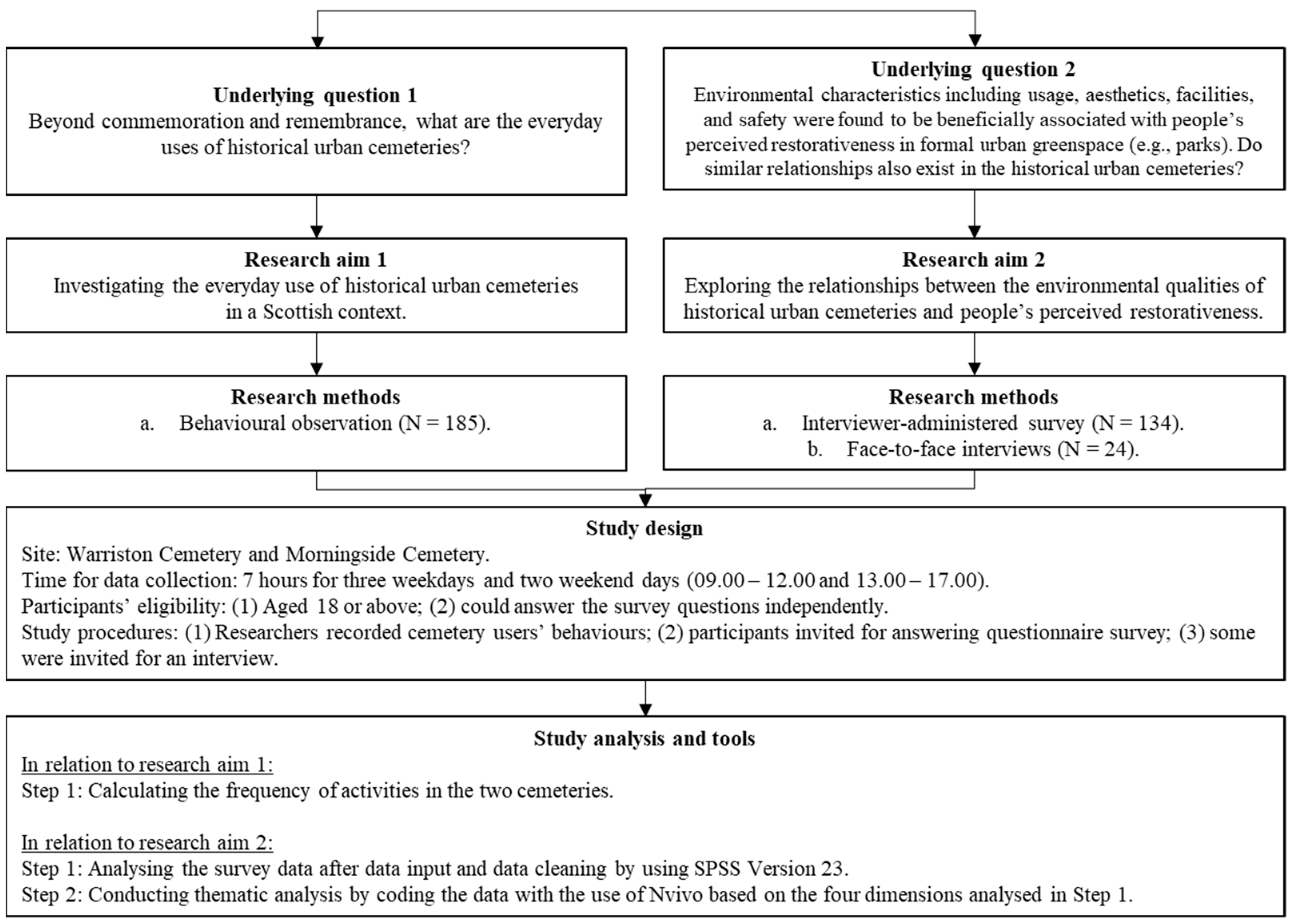
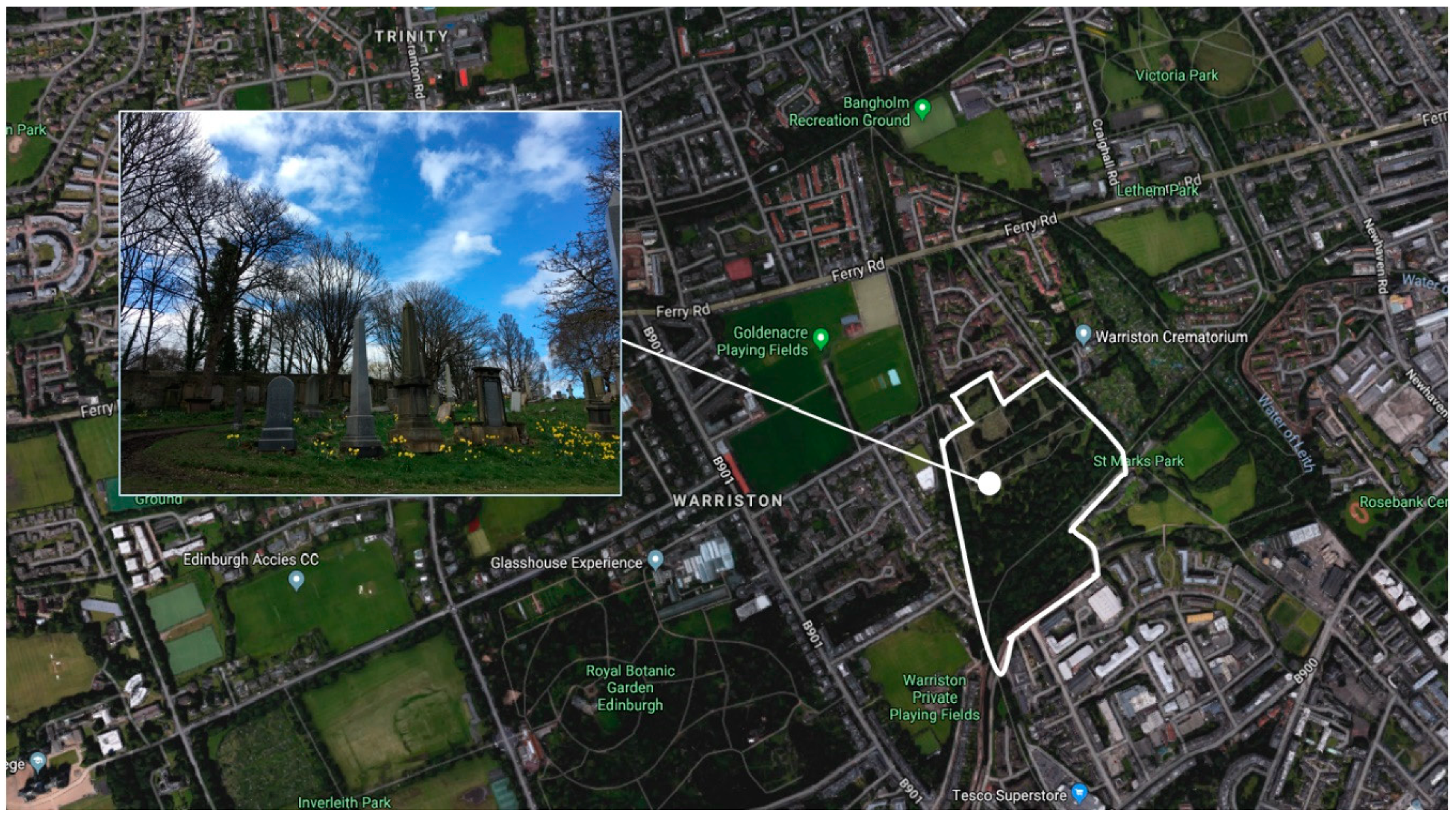
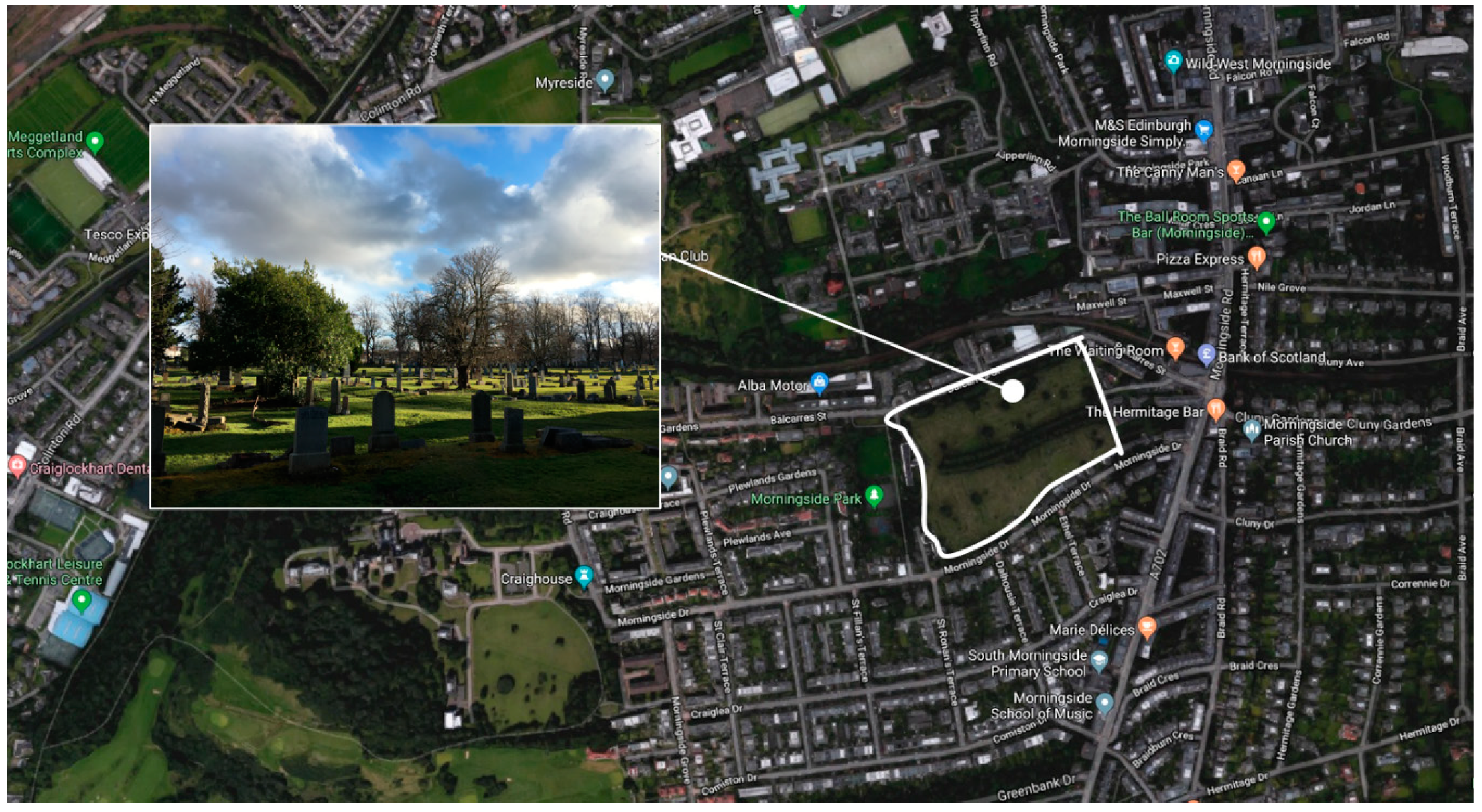
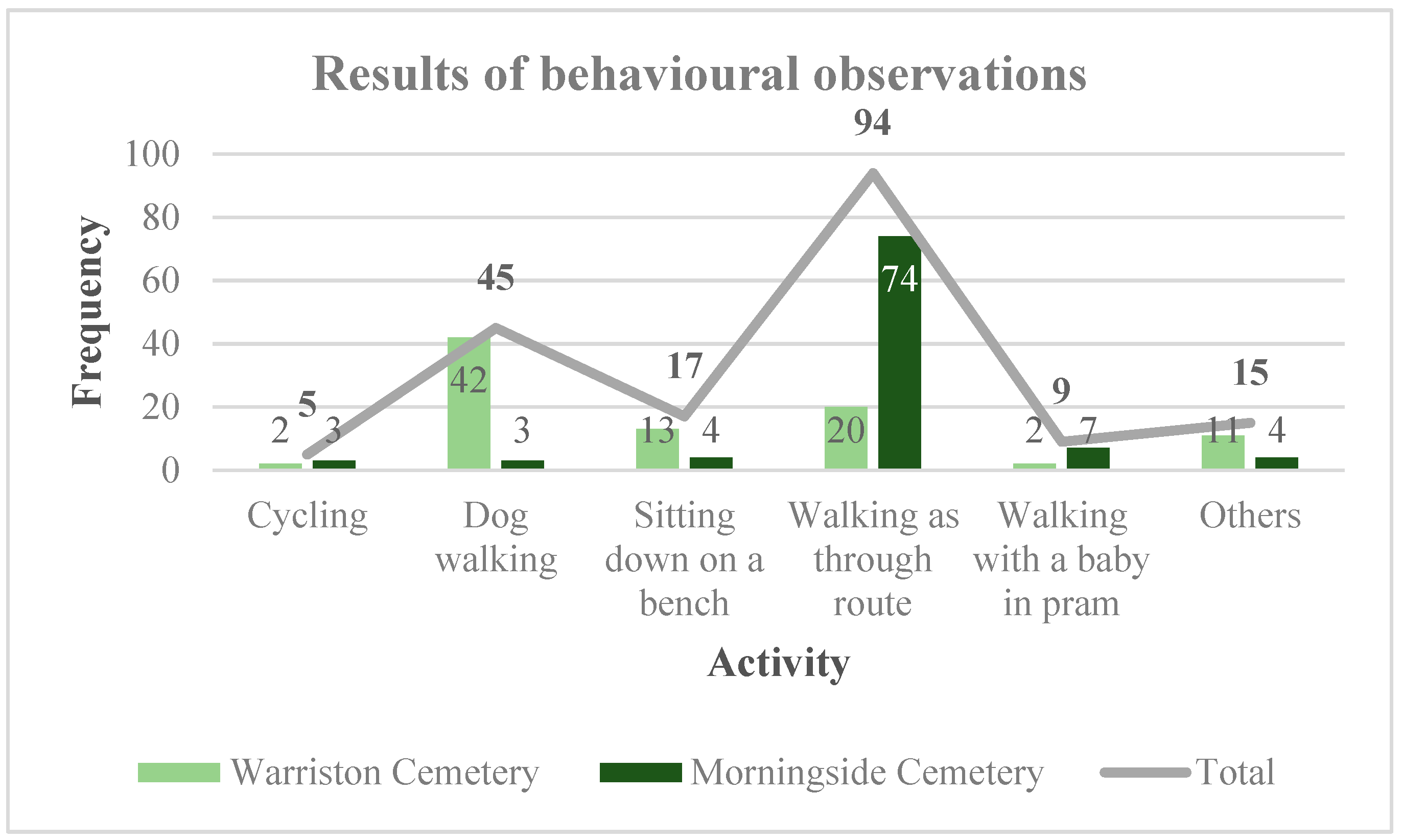
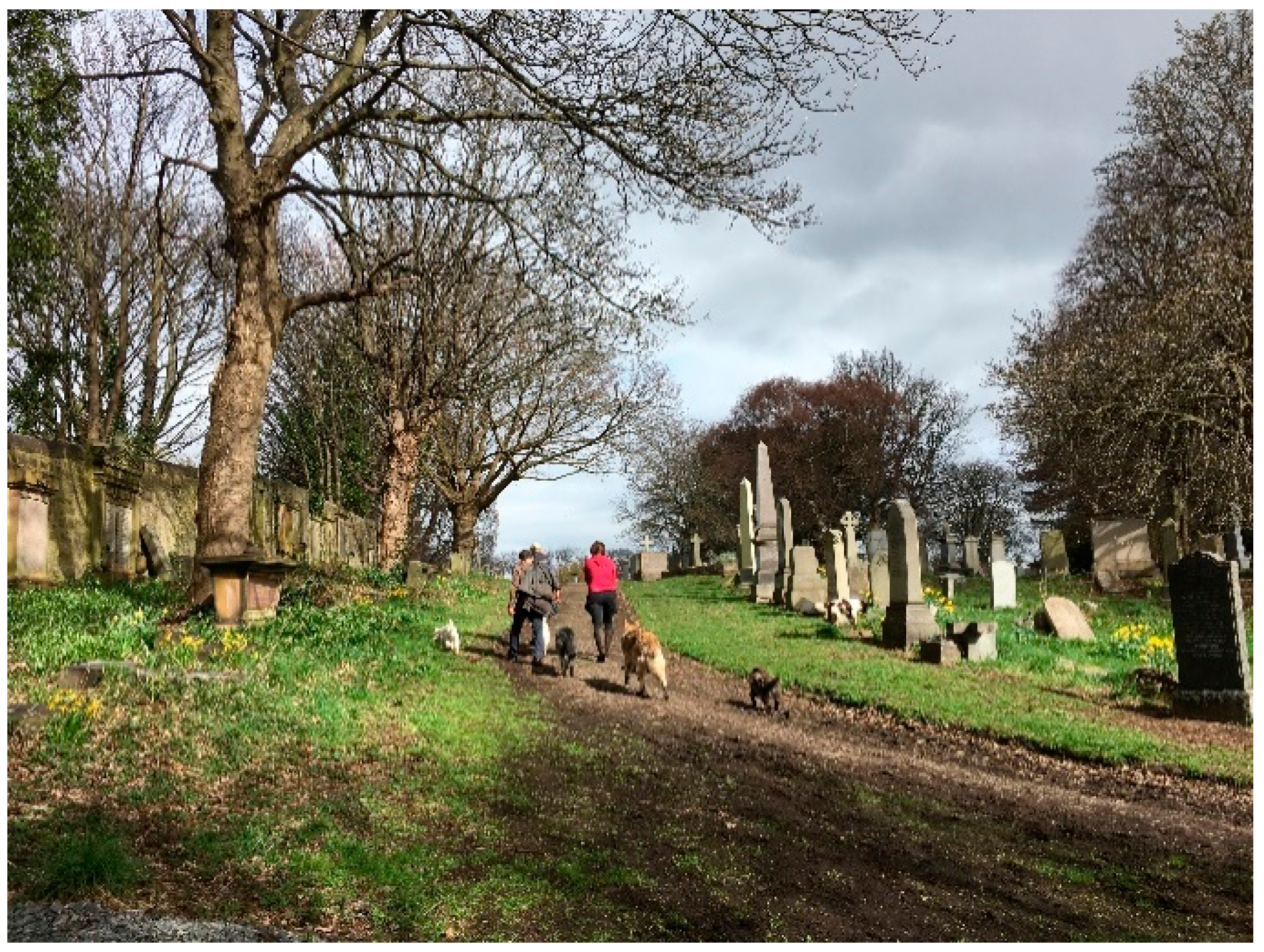
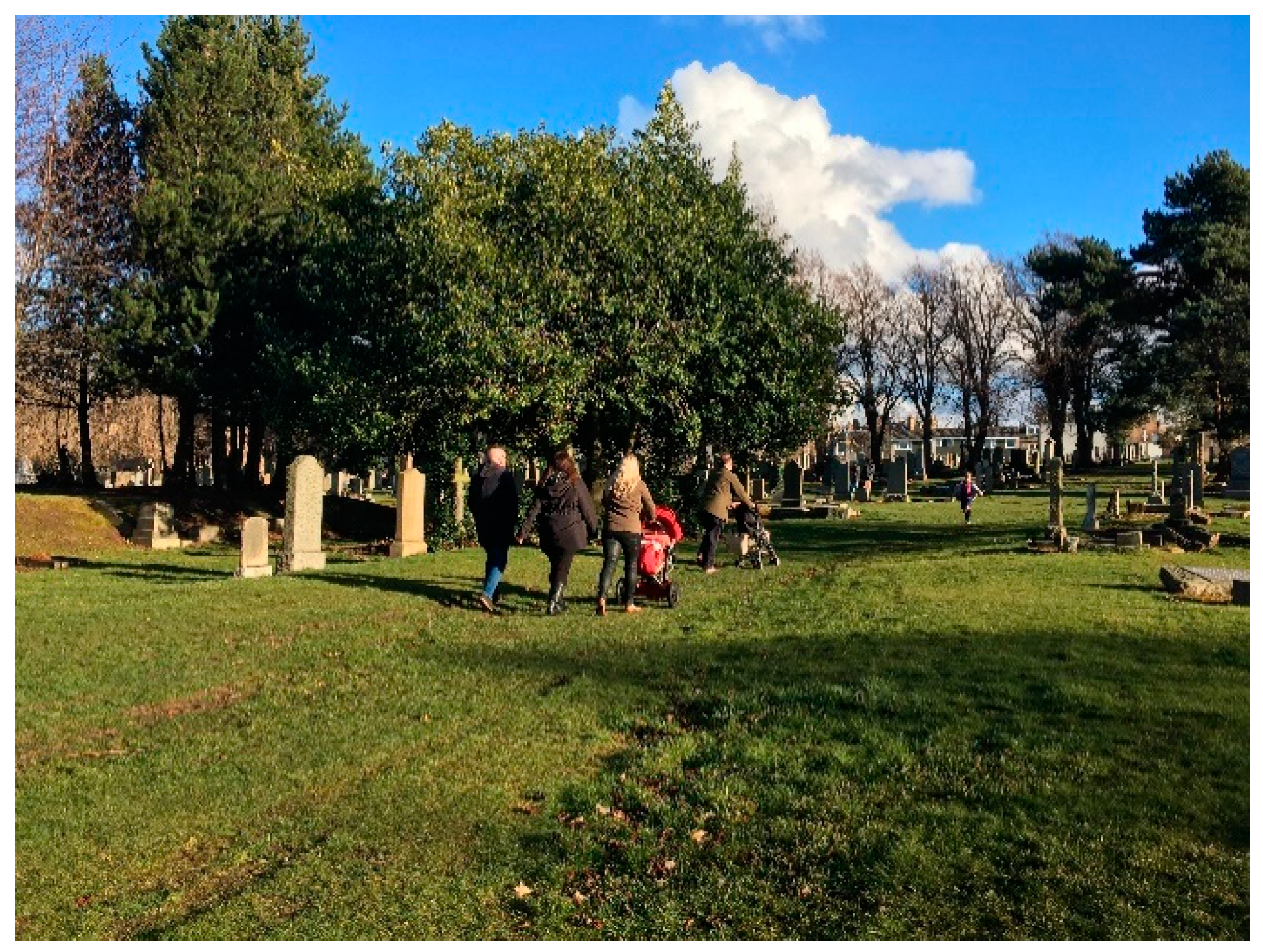
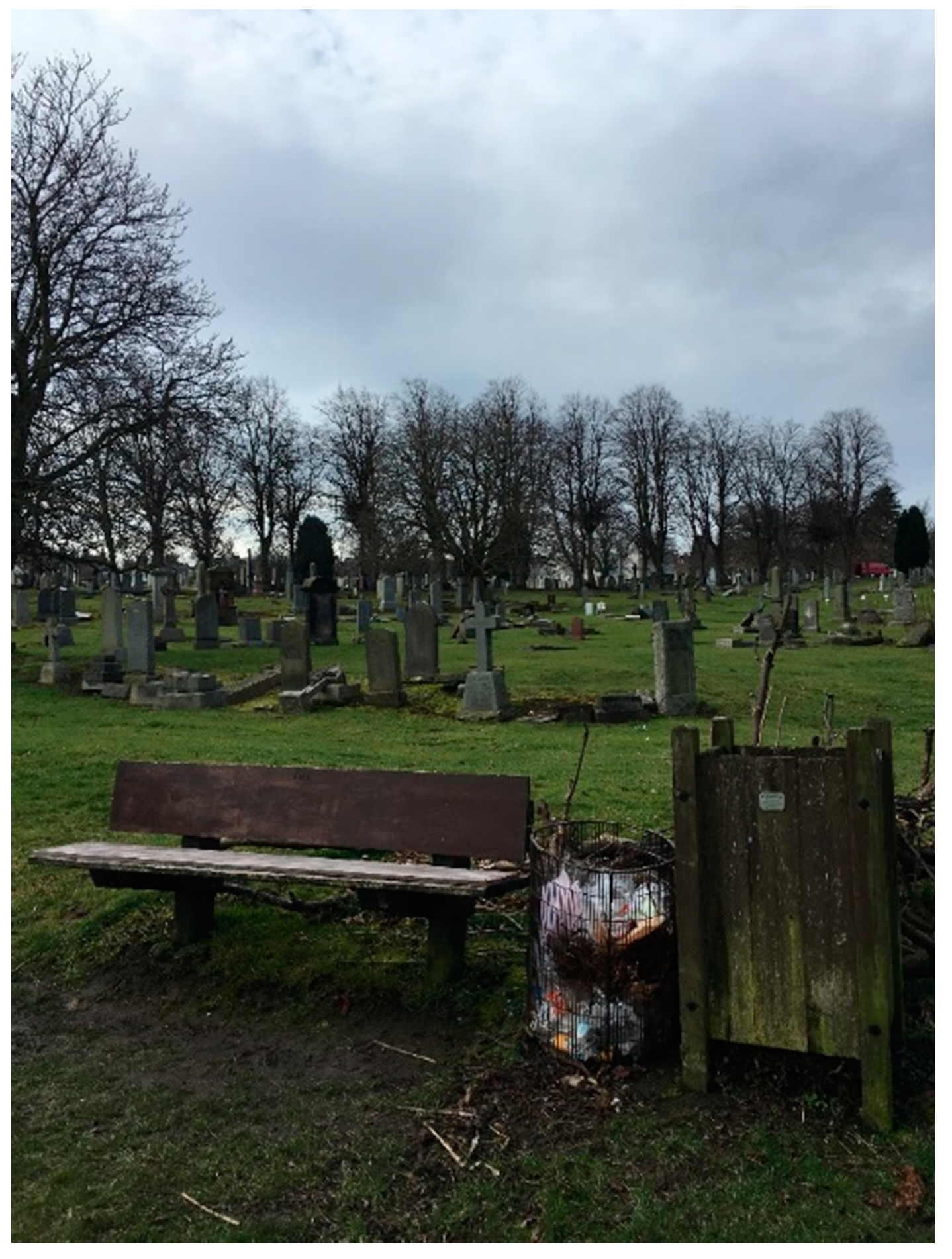
| N/M | %/SD | |
|---|---|---|
| Study site | ||
| Warriston Cemetery | 65 | 48.5% |
| Morningside Cemetery | 69 | 51.5% |
| Sociodemographic characteristics | ||
| Age (years) | 49.79 | 17.16 |
| Male | 60 | 44.8% |
| Marital status | ||
| Single | 47 | 35.1% |
| Married | 60 | 44.8% |
| Cohabitated | 9 | 6.7% |
| Divorced/separated/widowed | 18 | 13.4% |
| Education level | ||
| Secondary school or below | 23 | 17.2% |
| Technical school or similar level | 23 | 17.2% |
| Undergraduate degree | 49 | 36.6% |
| Postgraduate degree | 39 | 29.1% |
| Working status | ||
| Employed/self-employed | 78 | 58.2% |
| Unemployed | 20 | 14.9% |
| Retired/partially retired | 36 | 26.9% |
| Without physical disability | 131 | 97.8% |
| Variable | M (SD) | Safety | Usage | Facilities | Aesthetics |
|---|---|---|---|---|---|
| 16-item PRS scale (0–6) | 4.03 (1.03) | 0.063 | 0.569 ** | 0.188 * | 0.370 ** |
| Being away (0–6) | 3.97 (1.72) | 0.025 | 0.458 ** | 0.063 | 0.318 ** |
| Compatibility (0–6) | 3.57 (1.49) | 0.114 | 0.557 ** | 0.214 * | 0.358 ** |
| Fascination (0–6) | 3.86 (1.46) | 0.069 | 0.571 ** | 0.150 | 0.291 ** |
| Coherence (0–6) | 4.83 (.98) | −0.102 | −0.129 | 0.052 | 0.057 |
| 16-item PRS Scale a | Being Away a | Compatibility a | Fascination a | |||||||||
|---|---|---|---|---|---|---|---|---|---|---|---|---|
| Variable | B | SE B | β | B | SE B | β | B | SE B | β | B | SE B | β |
| Usage | 0.630 | 0.111 | 0.419 ** | 0.766 | 0.208 | 0.305 ** | 0.898 | 0.166 | 0.413 ** | 0.837 | 0.158 | 0.393 ** |
| Facilities | 0.064 | 0.073 | 0.060 | −0.111 | 0.136 | –0.063 | 0.146 | 0.109 | 0.096 | 0.060 | 0.104 | 0.040 |
| Aesthetics | 0.381 | 0.101 | 0.275 ** | 0.630 | 0.189 | 0.272 ** | 0.480 | 0.151 | 0.240 ** | 0.410 | 0.144 | 0.209 ** |
| R2 | 0.516 | 0.390 | 0.478 | 0.509 | ||||||||
| F | 8.398 ** | 5.023 ** | 7.191 ** | 8.160 ** | ||||||||
© 2019 by the authors. Licensee MDPI, Basel, Switzerland. This article is an open access article distributed under the terms and conditions of the Creative Commons Attribution (CC BY) license (http://creativecommons.org/licenses/by/4.0/).
Share and Cite
Lai, K.Y.; Scott, I.; Sun, Z. Everyday Use of the City Cemetery: A Study of Environmental Qualities and Perceived Restorativeness in a Scottish Context. Urban Sci. 2019, 3, 72. https://doi.org/10.3390/urbansci3030072
Lai KY, Scott I, Sun Z. Everyday Use of the City Cemetery: A Study of Environmental Qualities and Perceived Restorativeness in a Scottish Context. Urban Science. 2019; 3(3):72. https://doi.org/10.3390/urbansci3030072
Chicago/Turabian StyleLai, Ka Yan, Iain Scott, and Ziwen Sun. 2019. "Everyday Use of the City Cemetery: A Study of Environmental Qualities and Perceived Restorativeness in a Scottish Context" Urban Science 3, no. 3: 72. https://doi.org/10.3390/urbansci3030072
APA StyleLai, K. Y., Scott, I., & Sun, Z. (2019). Everyday Use of the City Cemetery: A Study of Environmental Qualities and Perceived Restorativeness in a Scottish Context. Urban Science, 3(3), 72. https://doi.org/10.3390/urbansci3030072





